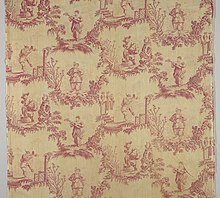Percale

Percale[1]is a closely wovenplain-weavefabricoften used forbed covers.Percale has athread countof about 140 or higher and is noticeably tighter thantwillorsateen.It has medium weight, is firm and smooth with no gloss, and washes very well. It is made from bothcardedandcombedyarns,and may be woven of various fibers, such ascotton,polyester,or various blends.[2]
History[edit]
Morisormauriswas the 18th-century French term used for percale, the cloth imported from India.[3][4]It was acottoncloth. Moris was the third most exported fabric fromCoromandel CoastafterLongclothandSalampore.It was superior and finer quality than the peers. Coromandel coastline forms a part ofTamil NaduandAndhra Pradesh.Moris was produced atNellore,Arni,Maduranthakam,andCuddalore.Palakollu.The cloth was famous as painted chintz in southeast countries also.[5][6][7][8]
Percale was formerly imported from India in the 17th and 18th centuries,[9]then manufactured in France.[10]
Etymology[edit]
The word may originate from thePersian:پرگاله:pargālah,meaningrag,[11][12]although theOxford English Dictionary(as of December 2005) has traced it only as far as 18th-century French. The dictionary of theInstitut d'Estudis Catalansdescribespexalandperxalassome kind of silk fabric in the year 1348 inValencia.[13]The etymological dictionary of Catalan explainsperxalasderived fromPerchein France.[14]
See also[edit]
References[edit]
- ^How India clothed the world: the world of South Asian textiles, 1500–1850,volume 4 of Global Economic History series, p. 440, Giorgio Riello, Tirthankar Roy, Om Prakash, published by Brill, 2009,ISBN978-90-04-17653-9.
- ^"Fabric Glossary".Dotmaisonmagazine.
- ^Wellington, Donald C. (2006).French East India Companies: A Historical Account and Record of Trade.Hamilton Books. p. 223.ISBN978-0-7618-3475-5.
- ^Wingate, Isabel Barnum (1979).Fairchild's dictionary of textiles.Internet Archive. New York: Fairchild Publications. p. 378.ISBN978-0-87005-198-2.
- ^Arasaratnam, Sinnappah; Arasaratnam, Professor and Head of Department of History Sinnappah; Arasaratnam, Maritime History Scholar and Professor of Indian History S. (1986).Merchants, Companies, and Commerce on the Coromandel Coast, 1650-1740.Oxford University Press. pp. 99, 52, 340.ISBN978-0-19-561873-0.
- ^Journal of Indian History.Department of Modern Indian History. 2007. p. 23.
- ^Amrith, Sunil S. (7 October 2013).Crossing the Bay of Bengal.Harvard University Press. p. 53.ISBN978-0-674-72846-2.
- ^How India Clothed the World: The World of South Asian Textiles, 1500-1850.BRILL. 31 July 2009. p. 289.ISBN978-90-474-2997-5.
- ^Jennifer Speake,ed. (1999)."percale, noun".The Oxford Essential Dictionary of Foreign Terms in English.Berkley Books.Retrieved18 December2007.
{{cite book}}:|website=ignored (help) - ^"percale,n. and adj.",Draft Revision Dec. 2005, Oxford English Dictionary
- ^"percale",The American Heritage Dictionaries,atanswers.com
- ^A comprehensive Persian-English dictionary: including the Arabic words and phrases to be met with in Persian literature, being, Johnson and Richardson's Persian, Arabic, and English dictionary, revised, enlarged, and entirely reconstructed, The World's Most Detailed and Comprehensive Persian-English Dictionary, Francis Joseph Steingass, Asian Educational Services, 1992.ISBN978-81-206-0670-8
- ^Diccionari Aguiló: materials lexicogràfics / aplegats per Marià Aguiló i Fuster; revisats i publicats sota la cura de Pompeu Fabra i Manuel de Montoliu, page 134,Institut d'Estudis Catalans,Barcelona 1929.
- ^Diccionari etimològic i complementari de la llengua catalana: O-Qu.- 1986, cop. 1985.- 977 p, page 464, Joan Corominas, Joseph Gulsoy, Max Cahner, Curial Edicions Catalanes, 1995.ISBN978-84-7256-276-9
External links[edit]
 Media related toPercaleat Wikimedia Commons
Media related toPercaleat Wikimedia Commons
